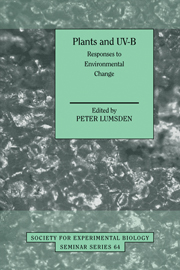Book contents
- Frontmatter
- Contents
- List of contributors
- Preface
- PART I The ozone layer and UV-B radiation
- PART II Effects of UV-B on plants at the cellular level
- PART III Effects of UV-B at the whole plant and community level
- Effects of solar UV-B radiation on aquatic ecosystems
- Assessing the impact of UV-B radiation on the growth and yield of field crops
- Effects of UV-B radiation on plants from agro- and natural ecosystems
- Effects on subarctic vegetation of enhanced UV-B radiation
- Impacts of elevated UV-B on forest ecosystems
- Effects of elevated UV-B radiation and elevated CO2 on heathland communities
- Alterations in competitive balance
- Interations between trophic levels
- Index
Alterations in competitive balance
Published online by Cambridge University Press: 04 August 2010
- Frontmatter
- Contents
- List of contributors
- Preface
- PART I The ozone layer and UV-B radiation
- PART II Effects of UV-B on plants at the cellular level
- PART III Effects of UV-B at the whole plant and community level
- Effects of solar UV-B radiation on aquatic ecosystems
- Assessing the impact of UV-B radiation on the growth and yield of field crops
- Effects of UV-B radiation on plants from agro- and natural ecosystems
- Effects on subarctic vegetation of enhanced UV-B radiation
- Impacts of elevated UV-B on forest ecosystems
- Effects of elevated UV-B radiation and elevated CO2 on heathland communities
- Alterations in competitive balance
- Interations between trophic levels
- Index
Summary
Interspecific competition
Ecosystem-level influences of increased solar UV-B (280–320 nm) radiation are only beginning to be explored. Predicting interactions of species in ecosystems based only on studies of plants in isolation is difficult or often impossible. Changes in the competitive balance of higher plants can result when species mixtures are exposed to different levels of UV-B as explained later. How might this come about? Intuitively, one might postulate that if a species is more detrimentally affected by increased solar UV-B than other species, its competitive position in the community would suffer. This might be reasonable if sizeable differences between species in UV-B damage arise. However, a review of the relevant literature suggests that, when tested under field conditions, most higher plants do not suffer appreciable damage when given additional UV-B simulating reasonable changes in the stratospheric ozone layer (Caldwell & Flint, 1993, 1994). While little apparent detrimental effect of elevated UV-B is apparent in monocultures of higher plants, there are several reports that the competitive balance between plant species can be altered when additional UV-B is given to mixtures of species (Fox & Caldwell, 1978; Gold & Caldwell, 1983; Barnes et al., 1988) or even when solar UV is largely excluded (Bogenrieder & Klein, 1982).
Higher plants appear to be reasonably well protected against damage or growth inhibition by UV-absorbing pigments and damage repair systems (Tevini, Braun & Fieser, 1991; Li et al, 1993; Britt, 1995; Britt et al, 1993; Fiscus & Booker, 1995).
- Type
- Chapter
- Information
- Plants and UV-BResponses to Environmental Change, pp. 305 - 316Publisher: Cambridge University PressPrint publication year: 1997
- 10
- Cited by

